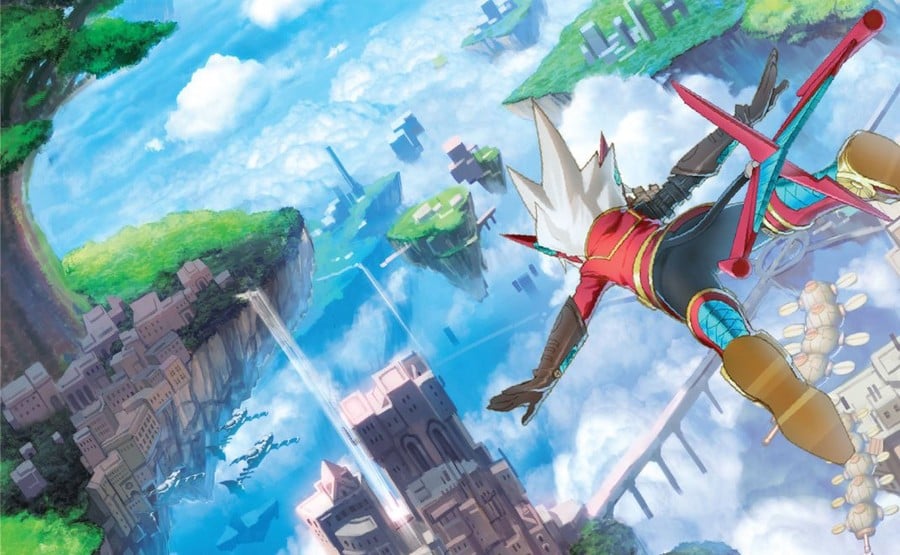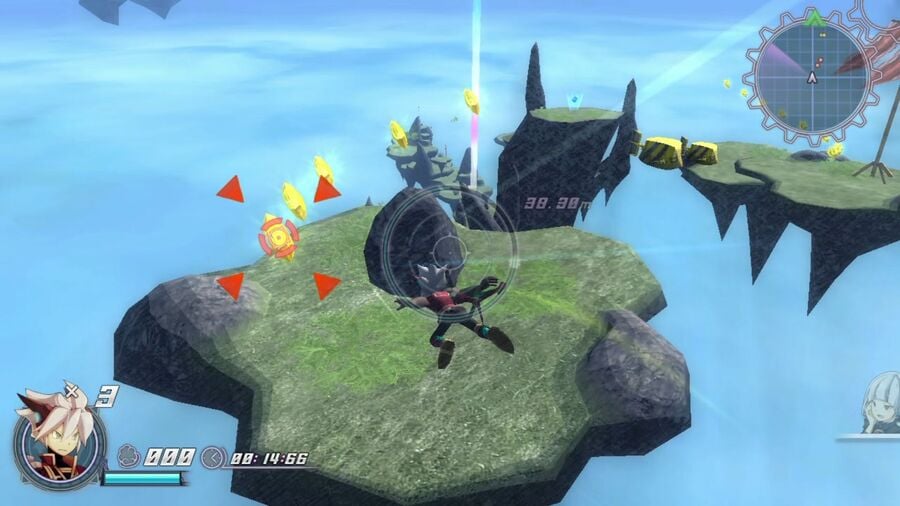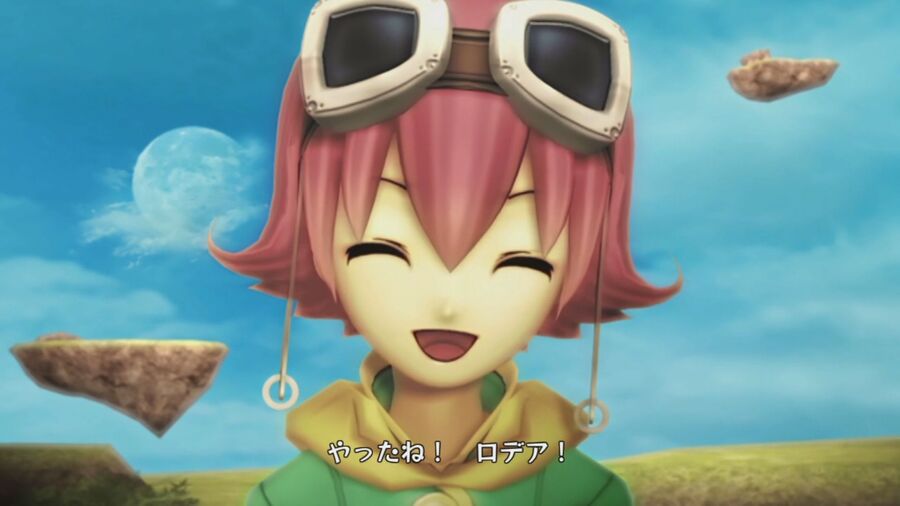
Rodea the Sky Soldier has had quite a turbulent time in development. Originally announced in 2010 for the Wii, this character-driven flight action game from Sonic and NiGHTS into Dreams creator Yuji Naka looked set to soar, but ultimately never got off the runway. After years of radio silence, Rodea was cleared for takeoff as a rebuilt Wii U and 3DS title in 2014, with NIS America taking the reigns on the Western release. We got to go hands-on with the Wii U version of the game last month at E3, and were very pleased to see how it's been shaping up - we had a great time arcing through the air with Rodea.
Our demo began with an anime-inspired cutscene, and though we didn't glean too many story details from our brief introduction, Rodea's world seems like an intriguing one - there's the peaceful sky kingdom of Garuda and the mechanized empire of Naga below, and Rodea is a robotic relic of a long-forgotten conflict between the two. We started out in Garuda, and the art style grabbed us immediately - it was as bright and captivating as you could hope for from a kingdom in the clouds, and left us excited to take to the skies.

The main goal of the stage we played was to make it from start to finish by flying over, under and around a series of floating islands, platforms and pipes. Rodea's main movement flow consisted of pressing 'A' to jump, 'A' again to pause and hover in the air and, after adjusting your aim with the analogue sticks, 'A' once more to start flying into the screen. Careening around using this three-step setup felt great; it reminded us of hurtling through Hekseville in Gravity Rush, and though there wasn't an option for gyroscopic GamePad aiming, the two analogue sticks work in concert to help line up flightpaths - we used the right stick (also serving as camera control) for larger movements, and the left stick for smaller adjustments.
Once we got the hang of the basics we were able to start soaring in earnest, and that's when Rodea's level design differentiated it from other airborne action games. The world was littered with floating chips called 'Gravitons', arranged in snaking paths between platforms, over the ground and climbing up walls. If Rodea flies into any Graviton in a given sequence, he'll zip straight through the whole line and drop off where it finishes. Flying along Graviton paths quickly became our main mode of travel through the stage, and it was snappy and fun; it felt like using Sonic's Light Dash in the Adventure games, but with an added sense of analogue freedom, since Rodea can pop out of a path and hover in place at any time with a tap of the 'A' button.
The Sonic parallels didn't end with Gravitons, either. We also found several sequences of enemies that fulfilled a similar purpose, serving as paths to link up platforms and islands. By pressing 'B' instead of 'A' to start flying, Rodea can drill-dash into his target, and we used this technique to bounce between baddies, Homing Attack-style, to reach our destination. Other than these stepping stones, there weren't too many foes to contend with as we made our way to the goal. One section had us using a gun to shoot down a few enemies and solve some quick puzzles, but this felt a bit out of place - happily, for the most part, as in the Klonoa games, enemies in Rodea acted more like environmental elements than outright aggressors, which seemed to fit the tone and rhythm of the game much better.

Rodea certainly reminded us of plenty of other games while we were playing, but on the whole it felt wonderfully unique, especially in its movement and feeling of flight. It's worth noting that the controls took a bit of getting used to - we fell and dropped our sequence quite a few times, but it was easy enough to recover, and our transitions became more fluid as we played. Once the controls clicked gliding around the stage was exhilarating, and the stop-and-go sequence of hurtling, hovering, readjusting and arcing through the air again never got old. When we were doing well we spent very little time on the ground, and though Rodea's flight time is limited - indicated by a circular clock-face around the aiming reticule - the level seemed designed so that the right lines would keep you airborne as long as possible, and trying our best to follow those made for a thrilling flight.
Rodea has been a long time coming and, from the looks of it, it will have been worth the wait - we had a great time with what we played. We loved the feeling of flying around, the wide-open yet focused level design and the beautifully inviting world, and can't wait to jump back in with the full version. There's also the 3DS version to keep an eye on, as well as the motion-controlled Wii original - included as a free bonus with first-run copies of the Wii U game - so there should be plenty of airborne platforming action for everyone when Rodea releases in Europe and North America this Fall.
Be sure to check out our other hands on features from E3:
- Heading Back to the Farm in Return to PopoloCrois: A Story of Seasons Fairytale
- Basking in the Glow of Atlus' Legendary Lineup
- Digging Up Details on Harvest Moon: Seeds of Memories
- Getting Into The Spirit With Yo-Kai Watch
- Plugging In To Chibi-Robo!: Zip Lash
- Logging More Flight Time With Star Fox Zero
- Celebrating a Gaming Icon With Super Mario Maker
- Our Impressions of the Full Nindies@Home Line-Up
- Getting Into the Fold With Mario & Luigi: Paper Jam
- Linking Up in The Legend of Zelda: Tri Force Heroes
- Holding Court with Mario Tennis: Ultra Smash
- Our Maiden Flight In Star Fox Zero Prompts Mixed Emotions
- Kicking Off With Metroid Prime: Blast Ball


Comments 48
I'm on the fence about this game
I feel like this game is gonna be a real hidden gem. Honestly considering preordering if the "get the Wii version as a bonus" thing is still going on.
@kkslider5552000 I never understood how it is a bonus if you have to pay extra for it. lol
Might get this in October
Is this a new IP, or based off some type of Anime TV show or something?
Looks pretty cool...
This thing better deliver, will wait for NL review before committing.
@uhhhhhhhh original.
Not really feeling it just from this trailer alone. Thats too bad too cause it looked promising.
This impression was from E3?
I hope it turns out great, I like how it looks. Shame about its performance in the homeland, hopefully it does better in the west.
I was still on the fence about this game but at the mention of Gravity Rush, my interest in this has certainly gone up a notch. Absolutely loved GR (certainly one of my favourite games ever) & the ability to fly & hurl around among many things, so if the controls/flying are similar to that, I may just pick this up for the 3ds when it releases in October.
Seems like it could be a bit of a hidden gem.
I'm curious to learn more about exploration in this game. It seems more action focused from what I've seen, but exploration is what I really crave for in my 3D adventures.
I should have extra cash in my pockt then. I'll probably pick this up instore if I see it.
This looks cool!
Already have it preordered on WiiU/Wii. SO excited for this- hugely!
@kkslider5552000 Same here, can't decide if I want the game or not. I don't want to miss out on a hidden gem, but I'm not sure if the game itself will be any good. The trailers and gameplay footage haven't really sold the game to me yet.
I'm glad I'm not alone in being unsure whether I want to get this game or not. There's just something about the gameplay I've seen so far that's not doing it for me.
This dropped out of my shopping list as soon as I noticed that they had down graded the controls.
Seems promising
Really can't wait for this game I LOVED NiGHTS on the wii and wished for a sequel forever! Im hoping this game does good in the US! Pre ordered the big LE from Nisamerica.
The Wii version is the one worth playing. The Wii U and 3DS versions are slower, uglier, control worse and run at a lower framerate.
Interesting at least.
I have some hope for this game but that trailer is sooooooo baaaadddd...
I'd get the 3DS version of anything I think at this point
This and Legend of Kay have been some suprising titles that have hit the platform that look quality.
@accc Are you serious?
I'm not interested in the game, but I'm totally into the art and the whole world they live in. I would love to be in a world with floating islands. Man was Skyward Sword awesome.
Anyone know if the Wii version will be available for download or only through the physical copy pre-order?
@ikki5 how are you paying for it twice? It's being sold for $59.99, thats MSRP for a full quality game.
@indienapolis only through pre order.
@mordo887 Bummer. I went all digital this gen (small apartment) and had hoped it might be similar to how Bayonetta was handled. I wrote the company and they never got back. I guess that answers that.
@indienapolis sorry to hear that, the wii u version Should be digital; the games distribution is being taken care of by nis america incase you don't know.
@mordo887 Yeah, that's who I emailed. Thanks tho. I'll prob just pre-order the physical copy. It will sit with reverence, alone in my collection.
Question 2: Does the WiiU version have the option of the Wii controls?
Man, so great to hear that the Wii U version is fantastic! The 3DS version was trash...I played the demo on the japanese eShop when it came out months ago, really bad port.
Good to hear the gameplay is fun. Will probably pick this up when its released.
Mine is preordered. I want to try it with the Wii controls, for one. Plus, I just feel this need to support it. Not sure why, but I really wanna play it. It calls out to me.
I'm actually genuinely surprised this has got such a favourable preview, I opened this article fully expecting it to be mediocre at best. Its unusual for a game to go through the publishing problems this has and a switch of platforms and still turn out well.
It's made my day really because I was hoping it would harken back to Naka's previous works and it looks like it does, looking forward to this now.
I'm actually genuinely surprised this has got such a favourable preview, I opened this article fully expecting it to be mediocre at best. Its unusual for a game to go through the publishing problems this has and a switch of platforms and still turn out well.
It's made my day really because I was hoping it would harken back to Naka's previous works and it looks like it does, looking forward to this now.
3DS, if I do pick this one up. The visuals don't look to be complimented by the resolution upgrade. Animation is very stiff, but the game still seems reasonably interesting.
Funny how people were slating this game for ages now it's promising,while devils third has went from being intriguing to bad as both games approach release.
Like so many here, I am intrigued. Would not consider a pre-order, but for the bonus. Decision time approaching. Thanks NL for the first impression review.
Dual analog flying? Well, that sucks! Why couldn't they have used the left stick alone for the flight angle with gyroscopic camera control (that switches to an automatic behind-the-back camera on the ground with occasional slight adjustments made with the right stick)?
Well this was a game that actually had caught my attention in late 2014, but now that I've learned that it won't feature gyro controls, my interest heavily declined. Why the hell not? Especially since this was a Wii game at first.
And I usually don't they this, because I'm not at all a graphics elitist, but they really should've improved the graphics. They look just so outdated. @DiscoGentleman: Exactly!
@KO-Cub Yea man, that's what it reminds me of, too, and I have really fond memories of SS and the floating islands.
Looking forward to it. Already have the limited edition preordered from NIS's website. 3DS all the way!
I've been waiting for this game since I heard of it because a flying game for the Wii U sounded awesome. I wonder what all the differences between the Wii U version and the 3ds versions are.
@Hero-of-WiiU Yes. Try reading up on the game's development history. The Wii version was developed by Yuji Naka (a.k.a creator of Sonic the Hedgehog)'s team and was designed around the use of Wiimote controls to fly around in and explore large, detailed environments. It features an attractive art style with vibrant colors and runs at 60 fps. When the Wii version was put on hold, Kadokawa games ended up porting it to the 3DS, without Naka's involvement. The port was severely compromised, with heavily downgraded visuals, muted colors, a very low framerate, and a control scheme which was incapable of providing the same fast, free-flowing action of the Wii version. Then, they ported over the 3DS version to the Wii U rather than the Wii version, so while the Wii U version is an improvement over the 3DS version, it still has the same lower detail graphics (albeit in higher resolution), muted colors, slower framerate (30 fps, compared to the Wii version's 60), and slow, inadequate controls, which makes it pale in comparison to the Wii version as well.
Solatorobo?
This game seems good but I'm going to wait till it's a bit cheaper
@ikki5: I acquired and played it this weekend (thanks ebay!) and, well, I'm still on the fence about this game. I think once I get the control mechanics down, it will be a fun little romp. The Wii game pack in is really well done . . . two disks like the NTSC Bayonetta set, but also separate Wii instructional booklet and Wii cover artwork printed on back of Wii U cover.
Tap here to load 48 comments
Leave A Comment
Hold on there, you need to login to post a comment...